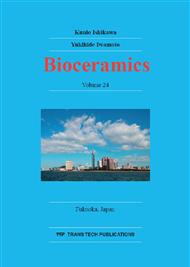[1]
A.J. Singer, et al. Prospective, randomized, controlled trial of tissue adhesive (2-octylcyanoacrylate) versus standard wound closure techniques for laceration repair. Stony brook octylcyanoacrylate study group. Acad. Emerg. Med. 5 (1998) 94–99.
DOI: 10.1111/j.1553-2712.1998.tb02590.x
Google Scholar
[2]
G.W. Herget, et al. Experimental use of an albumin-glutaraldehyde tissue adhesive for sealing pulmonary parenchyma and bronchial anastomoses. Eur. J. Cardiothorac. Surg. 19 (2001) 4–9.
DOI: 10.1016/s1010-7940(00)00613-8
Google Scholar
[3]
C.J. Dunn and K. L. Goa, Fibrin sealant: A review of its use in surgery and endoscopy. Drugs. 58 (1999) 863–886.
DOI: 10.2165/00003495-199958050-00010
Google Scholar
[4]
J.C. Webb and R. F. Spencer, The role of polymethylmethacrylate bone cement in modern orthopaedic surgery. J. Bone Joint Surg. Br. 89 (2007) 851-857.
DOI: 10.1302/0301-620x.89b7.19148
Google Scholar
[5]
A.J. Ambard and L. Mueninghoff, Calcium phosphate cement: review of mechanical and biological properties. J. Prosthodont. 15 (2006) 321-328.
DOI: 10.1111/j.1532-849x.2006.00129.x
Google Scholar
[6]
J. Charnley, Anchorage of the femoral head prosthesis to the shaft of the femur. J. Bone Joint Surg. 42B (1960) 28-30.
DOI: 10.1302/0301-620x.42b1.28
Google Scholar
[7]
A.P. Amar, et al. Percutaneous transpedicular polymethylmethacrylate vertebroplasty for the treatment of spinal compression fractures. Neurosurgery. 49 (2001) 1105-1115.
DOI: 10.1227/00006123-200111000-00017
Google Scholar
[8]
P. F. Heini and U. Berlemann, Bone substitutes in vertebroplasty. Eur. Spine J. 10 Suppl 2 (2001) S205-13.
Google Scholar
[9]
M. Stańczyk and B. van Rietbergen, Thermal analysis of bone cement polymerisation at the cement-bone interface. J. Biomech. 37 (2004) 1803-1810.
DOI: 10.1016/j.jbiomech.2004.03.002
Google Scholar
[10]
M.D. Ries, et al. In vivo behavior of acrylic bone cement in total hip arthroplasty. Biomaterials 27 (2006) 256-261.
DOI: 10.1016/j.biomaterials.2005.05.103
Google Scholar
[11]
J.A. Duncan, Intra-operative collapse or death related to the use of acrylic cement in hip surgery. Anaesthesia. 44 (1989) 149-153.
DOI: 10.1111/j.1365-2044.1989.tb11168.x
Google Scholar
[12]
R.J. Byrick, Cement implantation syndrome: a time limited embolic phenomenon. Can. J. Anaesth. 44 (1997) 107-111.
DOI: 10.1007/bf03012996
Google Scholar
[13]
J. Parvizi, A.D. Holliday, M.H. Ereth and D.G. Lewallen, Sudden death during primary hip arthroplasty. Clin. Orthop. Relat. Res. 369 (1999) 39-48.
DOI: 10.1097/00003086-199912000-00005
Google Scholar
[14]
R.J. Byrick, D. Forbes and J.P. Waddell, A monitored cardiovascular collapse during cemented total knee replacement. Anesthesiology. 65 (1986) 213-216.
DOI: 10.1097/00000542-198608000-00016
Google Scholar
[15]
H.L. Chen, et al. A lethal pulmonary embolism during percutaneous vertebroplasty. Anesth. Analg. 95 (2002) 1060-1062.
Google Scholar
[16]
C. Vasconcelos, P. Gailloud, J-B. Martin and K.J. Murphy, Transient arterial hypotension induced by polymethylmethacrylate injection during percutaneous vertebroplasty. J. Vasc. Interv. Radiol. 12 (2001) 1001-1002.
DOI: 10.1016/s1051-0443(07)61584-x
Google Scholar
[17]
J.A. Duncan, Intra-operative collapse or death related to the use of acrylic cement in hip surgery. Anaesthesia. 44 (1989) 149-153.
DOI: 10.1111/j.1365-2044.1989.tb11168.x
Google Scholar
[18]
J.M. Mayer, M. Greenberger, D.H. Ball, D.L. Kaplan, Polysaccharides, modified polysaccharides and polysaccharide blends for biodegradable materials, Polym. Mater. Sci. Eng. 63 (1990) 732-735.
DOI: 10.1007/978-94-009-2129-0_48
Google Scholar
[19]
T.D. Leather, Biotechnological production and applications of pullulan, Appl. Microbiol. Biotechnol. 62 (2003) 468-473.
Google Scholar
[20]
Y. Yoshida et al, Evidence of chemical bonding at biomaterial-hard tissue interfaces. J. Dent. Res. 79 (2000) 709-714.
DOI: 10.1177/00220345000790020301
Google Scholar
[21]
Y. Yoshida et al, Comparative study on adhesive performance of functional monomers. J. Dent. Res. 83 (2004) 454-458.
Google Scholar
[22]
S. Inoue et al, Hydrolytic stability of self-etch adhesives bonded to dentin. J. Dent. Res. 84 (2005) 1160-1164.
DOI: 10.1177/154405910508401213
Google Scholar
[23]
K. Yoshihara et al, Nano-controlled molecular interaction at adhesive interfaces for hard-tissue reconstruction. Acta Biomater. 6 (2010) 3573-3582.
DOI: 10.1016/j.actbio.2010.03.024
Google Scholar
[24]
K. Yoshihara, Y. Yoshida, S. Hayakawa, N. Nagaoka, M. Irie, T. Ogawa, K.L. Van Landuyt, A. Osaka, K. Suzuki, S. Minagi, B. Van Meerbeek, Nano-layering of phosphoric-acid ester monomer at enamel and dentin. Acta Biomater. 7 (2011) 3187-3195.
DOI: 10.1016/j.actbio.2011.04.026
Google Scholar
[25]
Yoshida, Y., Yoshihara, K., Nagaoka, N., Hayakawa, S., Torii, Y., Ogawa, T., Osaka, A., Van Meerbeek, B. Self-assembled nano-layering at the adhesive interface. J. Dent. Res. 91 (2012) 376-381.
DOI: 10.1177/0022034512437375
Google Scholar


